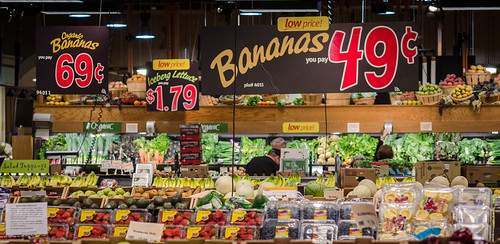
As an unbiased agricultural resource, Market News retail reports help encourage market stability and transparency by promoting healthy competition within the marketplace and providing equal access to market information for small and mid-sized producers and retailers.
Sound business decisions are based off of reliable data, and this is certainly the case for food producers and retailers. For small and mid-sized producers, access to timely and reliable data can be critical to their success. Whether they are selling products on the wholesale or retail market, producers need to quickly see the commodities in demand and how much they should be charging for their product or what products are the best buy for shoppers at that moment in time.
The entire agricultural supply chain turns to USDA Market News – administered by USDA’sAgricultural Marketing Service (AMS) – for the data they need when they need it. Serving stakeholders of all sizes and at all levels of trading, from small producer to retailer to consumer, USDA Market News allows producers and purchasers to realistically compare prices, trends, supply and demand from day to day and from market to market across the country. USDA Market News ensures that no group is disadvantaged by lack of information.
For retail data, Market News provides advertised retail pricing information, also known as weekly specials, for several hundred commodities at major retail supermarket outlets on a weekly basis. The information is gathered from publicly available sources like retailer websites from approximately 220 chain groceries, representing some 26,000 stores nationwide.
The data includes individual weekly reports for dairy, lamb, veal, pork, beef, poultry, eggs, and specialty crops (primarily fruits and vegetables). These reports represent weekly advertised retail prices by region, along with a national summary.
For instance, the National Retail Report – Specialty Crops, issued on June 10, 2016, lets you know that foods for summer barbecues and beach picnics were also being featured, including fresh local produce alongside lunch meats and cheeses, cuts for the grill, chips and ready-made desserts in the bakery. Looking for a deal? The same report lets you know that the prices for vine tomatoes were down by 21 percent.
All of the retail reports present the data in user-friendly pie charts, graphs, and of course raw numbers. The reports include current data, the previous week’s data, and data from the previous year. They even include pricing for organic products, and a percentage of the fruits and vegetables advertisements that are labeled as locally grown. For more detailed information on organic and locally grown produce, you can also visit the National Retail Local and Organic Report.
To simplify data collection for multiple commodities, Market News issues the Retail Summarized Dataset, which combines all the data represented in the individual retail reports and is available in various formats.
As an unbiased resource, Market News retail reports help encourage market stability and transparency by promoting healthy competition within the marketplace and providing equal access to market information for all producers and retailers. These reports also help producers adapt their production and marketing strategies to meet changing consumer demands, marketing practices and technologies.
If you are in the market for agricultural commodity retail data, be sure to visit the USDA Market News Retail Page.
No comments:
Post a Comment
Note: Only a member of this blog may post a comment.